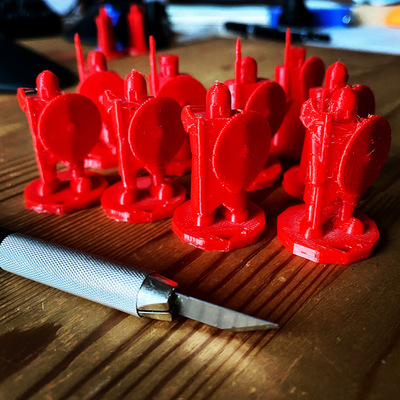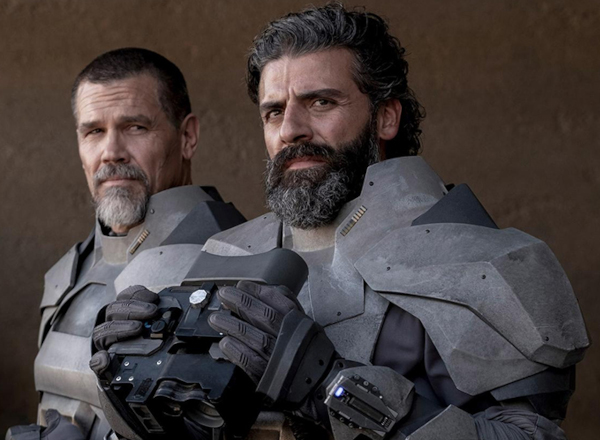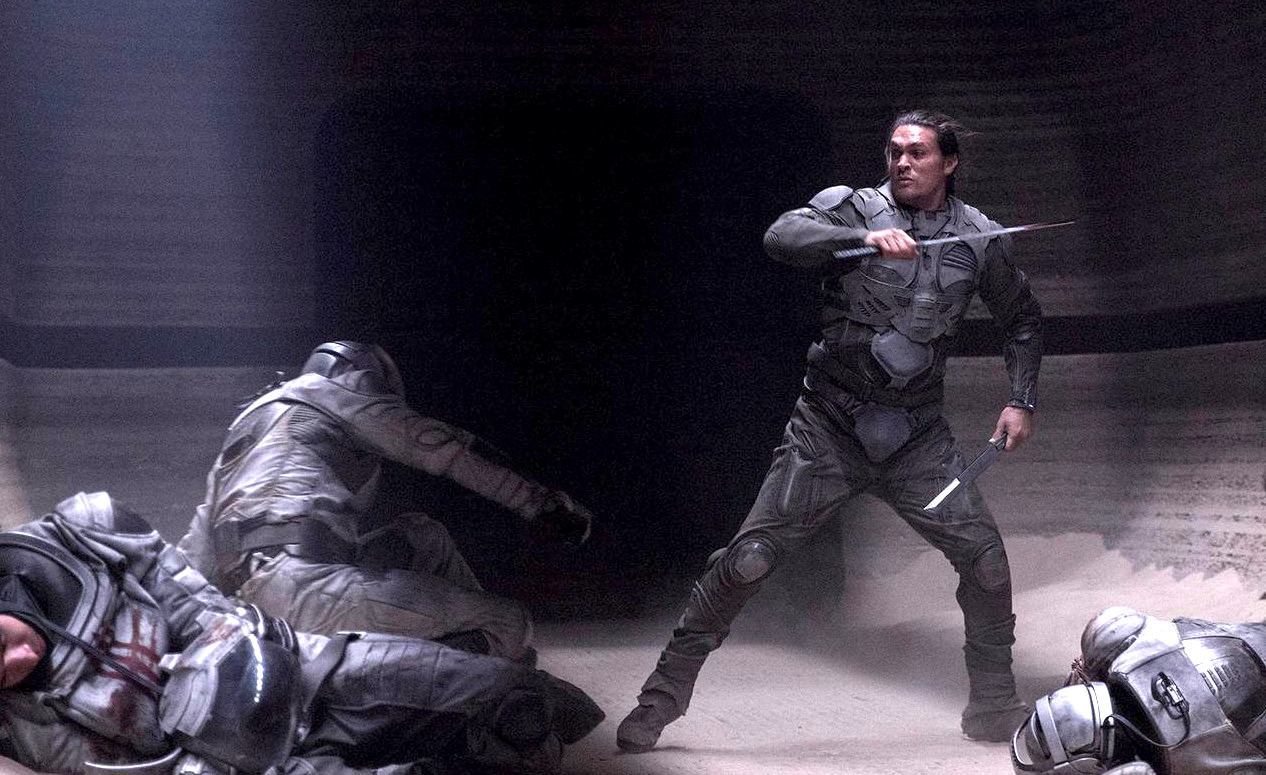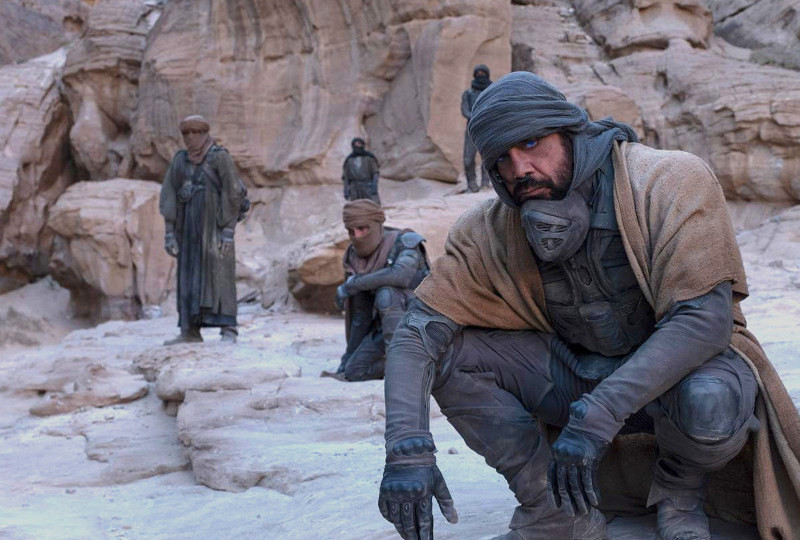
|
The Art of War in Dune |
| 2021-04-14 |
The Art of War in Dune
This is a translation of L'art de la guerre dans Dune (May 2013) by retired Colonel Michel Goya. He authorized me to translate and publish this article. Translation is treason... But I'm no Doctor Yueh.

Dune presents a rich universe mixing in a baroque but very coherent set, elements of past human societies and purely imaginary elements. War is waged in a particular way, but it stays war, with its own grammar.
How to destroy a great house
The political system in Dune is the result of a great convention (à la Magna Carta), it orchestrates relations between the Imperial House, the great feodal lords gathered in the Landsraad and the Navigator's Guild. War is tolerated as long as it doesn't disturb the power equilibrium. War happens between houses and, sometimes and under certain constraints, between the Throne and a house. The guild is usually neutral.
Those wars are limited by three factors. The first one is the fragmentation of power and avoiding that an actor (The Corrino Imperial House in the first place) becomes hegemonic. As soon as a house becomes too powerful, the others will ally against it. The second constraining factor is cost, particulary the transporation cost. An operation is generally performed from one world to the other and the transport is done by the Guild, spatial projection of force is very expensive. The last factor is atomic weapons. The Convention prohibits their use, but contrary to thinking machines, it does not prohibit their existence. We can thus consider (mapping nuclear disuasion principles from nation-states to Dune houses) that atomic weapons are relevant as a secundary weapon system, not very likely, or as ultima ratio.
The search for the total destruction of a great house, like the Atreide House, without using atomic weapons, is complex. A strategy of conventional first strike against the atomic arsenal of the enemy is difficult, especially with the use of force fields. The only solution is to strike down the adversary with an attack sufficiently fast and massive that gains a decisive result before the use of atomic weapons as ultima ratio. It was the engagement scenario in the error margin of the deterrence that General Hackett was describing in 1979 in The Third World War. It's evidently the option selected by Baron Vladimir Harkonnen.
The difficulty lies in that the cost of force projection and the efficacy of Holtzman field forces (they can be compared to fortress walls) favour defence over attack. To obtain an overwhelming ratio, one has thus to gather a considerable mass (overly expensive) and to benefit from a "fifth column".
Mass is reached by gathering all the Harkonnen forces and being helped by one or two Sardaukar legions, this brings quality (one Sardaukar being worth several regular fighters) and quantity. For Vladimir Harkonnen, the risk taking is doubled, militarily first as he exposes himself elsewhere, and financially, the expedition being overly expensive. Failure could prove fatal for House Harkonnen. It's a political risk for the Emperor Shaddam IV, the Landsraad may consider he broke the balance and contributed to the destruction, what is more through treachery, of a great house. The revelation of his intervention could ignite a general war against House Corrino. Thus the Sardaukars, like the "volunteers" of certain eras, fight under the Harkonnen livery. Quantity is quality in itself and the mass used for the operation, ten times superior to the one estimated by the Atreides Mentat, Thufir Hawat, contributes to the strategis surprise. And it happens before the Atreides could be reinforced with the alliance to the Fremen.
The massive Harkonnen assault is made considerably easier by the "fifth column" in the place, constituted by agents kept on Arrakis after the Harkonnen departure and especially by the traitor Yueh who not only switches off the Holtzman force fields of Arrakeen but also neutralizes Duke Leto. He is a trojan horse for the Atreides, he opens the door to the besiegers and allows taking down the head of of the besieged, the clausewitzian center of gravity for those political actors. When certain individuals are of disproportionate importance, one has to oppose them other individuals, only them being able to close in and strike.
In those conditions, the Harkonnen plan could only succeed, but like any complex plan, it couldn't succeed in its entirety.
Achilles and Holtzman

In Dune, fighter have access to the classical space opera weaponry, laser beams and force fields in particular, but the subtle thing is that, should the two meet, an explosion results with an intensity that can reach that of a small atomic weapon. It could give rise to interesting suicide tactics (especially with the low value placed on human life in that universe) notably against the big force field shields, but Frank Herbert tacitly excludes those tactics. In fact, one of the two technologies, laser, is not much used except when there are no shields in the opposing camp, as is notably the case in the Arrakis desert. Note in passing that it could have been the reverse, where the shield is considered too dangerous. That would have evidently changed the conditions in combat and the whole of the Dune universe, as the fight makes the army and the army makes the state.
The Holtzman force field resembles the knight's armor with the quasi invulnerability it gives its wearer, but there are two notable differences: unlike an armor, it confers no mobility disadvantage, and it is apparently inexpensive, which makes its use very common. Its only weakness is that it can be pierced by slow-moving objects, stabbing weapons evidently. Technology paradoxically imposes crawling back to ancestral ways of fighting. Herbert excludes collective phalanx tactics, which should still be possible, favouring a purely homeric style of combat, a collection of individual fights or fights in small teams (not much developped by the author, whereas one immediately sees the advantage two aggressors against a single shield bearer would have). Combat in Dune requires individual excellence, gained through a mix of warrior virtues, courage and aggressiveness in the first place, and fencing mastery. The acquisition of this excellence requires time and brings a de facto professionalisation and the constitution of a warrior aristocracy. This aristocracy then develops a specific culture giving it the monopoly on violence, which could maybe explain the refusal of mass tactics, but then renders it vulnerable to the rise of those mass tactics in the field. Civilian amateurs are excluded from the battlefield where their survival chances reach zero, and from wars themselves.
In the Illiad, heroes have a name, nameless warriors are their sidekicks. Dune has its share of fencing heroes like Duncan Idaho, Gurney Halleck, or Count Fenring, and the common soliders who are their sword fodder. Duncan Idaho can thus brag about having killed more than 300 souls in the service of Duke Leto. But heroes are rare and, although flamboyant, they don't make a noticeable difference in those battles, aggregations of thousands of micro-fights. Frank Herbert introduces thus a middle category that allies quantity to quality: elite fighters like the Sardaukars, the Fremen, and certain Atreides. The Fremen have the strongest warrior qualities, the Atreides are excellent technicians and the Sardaukars combine both characteristics at lower levels. Each of them is able to defeat several common soldiers and their presence decides the issue of the battles. That's the whole point of the presence of Sardaukars (10 to 20% of the headcount) in the assault force deployed by Vladimir Harkonnen against the Atreides, with the latent fear in the Baron of the Emperor directing them to sweep him ultimately. The interest of those elite troops, evident at the tactical level, is even more flagrant at the operational level, when one considers the cost of projecting a single man from one world to the other.
By the way, Frank Herbert insists a lot on the importance of extreme environments, like the Arrakis desert or the oppression of the prison planet Salusa Secundus, to develop warrior qualities. He is certainly thinking about the seventh centrury arab beduins that are his model for the Fremen. This theory is debatable, extreme environments generate mostly adapted but rigid, even trapped, societies. Inuits and Amazonian Indians, for example, never constituted conquering armies. Indirectly, this theory supposes as well that societies with high living standards are softening and that their armies are weak. History, notably World War Two, showed us that things are more complex.
The Fremen are a particular case in the military universe of Dune, they are at the same time perfectly adapted to their environment, they are very though in combat, and they are numerous. They thus introduce mass at an unknown scale in the equation. The Harkonnen assault, considered as formidable, mobilized 10 legions, roughly a few hundred of thousands of men, where the mentat Thufir Hawat was expecting a raid of at most a few tens of thousand men, a scale which seem to be the norm for those battles. Those numbers seem low when it comes to control a whole planet, but it seems the populations are not that large. With a population of ten million and their warrior culture, the Fremen may potentially align two to three million male adult fighters and as many secundary fighters. Evidently, that tilts the balance, as did the arrival of the Swiss pikemen in the second half of the fifteenth century or the revolutionary mass levy of 1792, that changed the face of war in Europe where, at those points, armies were small and professional. One may also think about the professional western contingents facing ten millions of Pashtuns old enough to bear arms in Afghanistan or Pakistan. The attitude and the allegiance of the Fremen are thus an essential point in the geopolitics of the Empire.
Stabilization Operation on Arrakis

Unless in case of total extermination, which is very rare, a military victory becomes a political victory only if the enemy accepts defeat. In the trinitarian scheme of Clausewitz, it's the political power that acknowledges defeat and accepts peace, the people not having any other option than to follow its government. If the military action doesn't just submits the opposing army but destroys the opposing political power as well, it deprives the winner from an interlocutor, and one or more other political powers may appear and may go on with the war one way or the other.
The United States are not the Harkonnen (they may be the Imperial House) and Paul Muad'dib is neither Oussama Ben Laden, nor Mullah Omar, nor is he Saddam Hussein. But the situation on Arrakis in 10191 after the fall of Arrakeen has some similarities with the 2001 Afghanistan or especially 2003 Iraq, but an Iraq that would be the sole oil producer in the world.
Indeed, the assassin war doesn't end with the death of Duke Leto, it simply transforms itself. The Atreides survivors join the endemic Fremen guerilla against the Harkonnen, whom they hate, to constitute a very efficient form of "coupled combat", coupling an external power and local fighters. Fremen bring their number, their warrior qualities, and their perfect adapation to the desert environment. The Atreides bring their family atomic arsenal, a "technical military assistance", and above all a charismatic leader, a cross between Lawrence of Arabia, the prophet Muhammad, and a Sudanese Madhi. It goes from an antibody reaction to a foreign hostile presence to a real jihad.
Facing this opposition that builds up gradually, the problem of the initial diagnostic arises systematically, and it's always tempting to minimize or to model according to one's own needs. For the french governement in 1954, the red toussaint authors in Algeria are simply bandits, while for the US command in 2003, guerilla attacks in the Iraqi Sunni triangle in May-June are the vanishing embers of the fallen regime and his leader on the run. This initial appreciation bounds the response and it is difficult to free oneself from those bounds later on. Veering away from the traditional policy of pure (economic) exploitation (in all the senses of the term) of Arrakis and unconstrained by humanitarian considerations that exist, at best, only among the signatories of the Great Convention, the Harkonnen and the Imperials as they take back the control of Arrakis see the Fremeen as a nuisance that has to be eliminated by extermination.
Tactically, we have the classical case of a technologically superior force facing a guerilla protected by its adaptation to a particular environement (jungle, mountain, rice paddy populations, Euphrate cities). On the other hand, Fremen do not benefit from the protection of Holtzman shields, since they annoy the sand worms. The temptation for the Harkonnen is thus strong to take fewer risks by leveraging air supremacy to hunt down the enemy and use laser against it.
Against this, rather inefficient, attrition strategy, the Fremen coordinated by Paul Atreides respond with an economic pressure strategy, preventing the enemy from exploiting the spice. The Sardaukars leave the front and the Harkonnen refuses to make any effort creating forces adapted to the desert, especially since, in a schema classic to dictatures, the reality of the situation on the ground is masked to the top of the organization. After a few years, Paul Atreides Go game strategy lets him control the biggest part of the planet and start precipitating the events. The threat, finally evident, on the production of spice causes a coalition of houses lead by the Emperor and thus the possibility of a final fight, but, more subtly, it causes the control of the Navigator Guild, completely dependent on spice. We thus reach the final stage of the People's War as described by Mao Zedong. The final battle against the Emperor is the equivalent to Dien Bien Phu in 10196.
The elimination of the defence shield of the Emperor is the major final tactical problem on the table. A big sandstorm is used to saturate the force field, but at first the mountains between the shield and the storm have to be levelled. The atomic taboo is broken indirectly, the weapon is engaged against a natural obstacle to allow the intrusion inside of the enemy camp. With the numerical and qualitative superiority of the Fremen and the surprise use of the sandworms, the fight tilts without doubt towards an Atreides victory. Strangely the fight ends with a homeric duel, a considerable risk as Muad'Dib is important, a risk that nothing justifies strategically.
